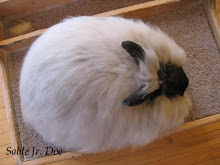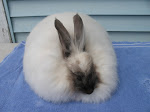Yesterday and today two litters were born to Bijou and Carmen, and I am waiting for two more over the next day or two from Diana and Kimba. Bijou gave birth to 6 kits yesterday (1 Black and 5 REW), and Carmen had the same exact number with some Black in her litter also, combined with a bunch of regular Torts. I can't wait to see the quality of these babies since I used a REW buck for both that is probably one of the best typed buns I have ever bred out. Spang's Diego is a REW F4 cross with fabulous type and density, but I have not been able to get him to the show table as yet due to his unfortunate tendency to spray himself and all others, LOL. With an incoming coat he has been moved to 'solitary confinement' in a corner of the barn with no neighbors to the top, bottom, or sides of him. He seems to be neater as a result, but we'll see how far it gets and if the temptation to hose something winds up getting the better of him anyhow, haha:).
Aside from this there is not much else going on, except that we are having warmer days and summer is on it's way along with heat, fans, ice packs, and all the other things that make this time of year a living hell for rabbit breeders:(. I weaned all the first litters of the year now and they are doing well at 7-8 weeks. In a little while I will begin taking them out and seeing how everyone looks (who seems to have potential and who doesn't) and begin the sorting process that peaks at week 12 when I decide who will stay and who will be sold to new homes and new breeding programs.
And as if all this weren't enough, a friend who is a 4-H Poultry leader emailed me recently about some ducklings who had been hatched in a Manhattan classroom and needed new homes. Although I have never owned ducks before (and wouldn't have minded keeping it that way), my dh and kids thought differently and decided to build a new place here for them to stay:). Needless to say we now have 9 little ducklings in our yard (one of whom is pictured below). There were 2 Cayugas and 7 Welsh Harlequins in the bunch, so hopefully they will provide lots of eggs and entertainment:).

More again next time and have a great week!

































